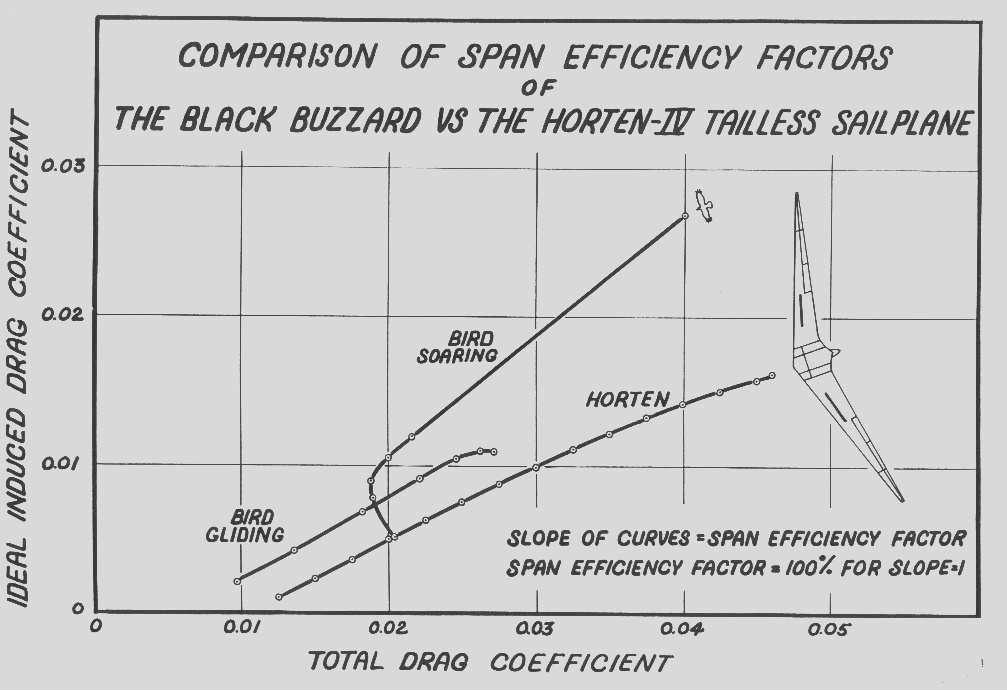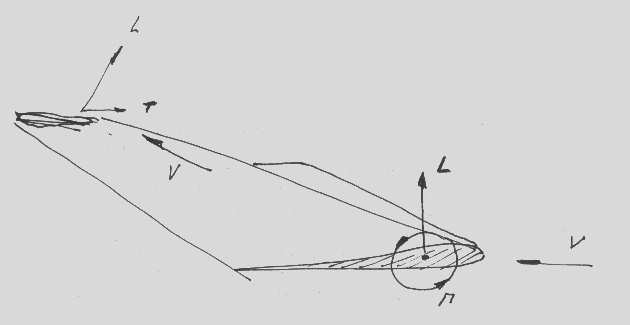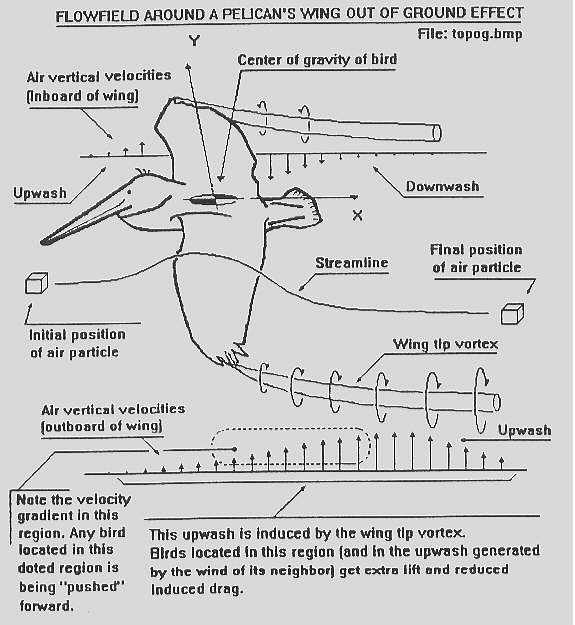| Andy
introduced Dr. Philip Burgers whose presentation today would cover the
issues that we have learned from flying wings and apply them to birds.
Phil began by telling us he had some good news and bad news. The
bad news was that he would be telling us who he is and what he has been
up to for the past several years. And the good news is that the presentation
will probably be shorter than the introduction.
(ed. - this did not turn out to be the case.) Three years ago he decided he needed to contribute something to the science of flight. To do this he elected to study the flight of birds and then translate what he found, if anything, to airplanes. This led to beginning a study of birds, but before getting into how they fly he thought he should determine how flight originated. What he found were two opposing theories, one which said birds started from the trees down (arboreal) and the other postulated it was from the ground up (cursorial). Although he would side with the overall nature of the cursorial theory, he found he didn't like either one, so about two years ago he came up with a new theory on how feathered wing animals became airborne from the ground up. He contacted the American Museum of Natural History and gave a presentation. This resulted in them giving him a grant to continue with his research. They liked it so much he was asked to submit an article to Nature magazine on this theory which he did with coauthor Dr. Luis Chiappe. It turns out their ideas are so controversial that the magazine’s editors have spent over nine months trying to decide on whether or not to publish it. Three out of three distinguished reviewers have said it should be published, and Phil thinks it will be in the magazine in the near future. As the word leaked out that Phil had come up with this new theory, he was honored with a request to give a presentation at a Yale University symposium in mid-February. So there he was, in front of 400 paleontologists, talking about adverse pressure gradients. Although they didn't understand a thing he was saying, the public did applaud when he finished, but he is still not sure why! He managed to return to TWITT and let us know about these pressure gradient things and how they relate to his love of airplanes. Today’s program was going to take a non-traditional approach to this subject by looking at the fluid dynamic flowfield surrounding flying wings and relate them back to what may be controversial findings about bird flight. He started with an old picture of a biplane about to crash on its nose in the dirt. This was meant to illustrate that you cant always believe what you see and that everything needs to be confirmed as fact before moving along to the next research step. One of the first wings Phil showed us was Hernan Posnansky’s 1986 sketch of his idea for a flying wing that helped launch TWITT. He noted how the aerodynamic center of a swinging wing changed in relation to a fixed center of gravity by having variable wing sweep in flight, and how birds that have read of Posnansky’s article in TWITT have better performance. The next comparison was from the work of Raspet showing some performance figures for gliding of a Horten IV and a black buzzard. He moved on to the Reimar Horten’s Piernifero, one of his most picturesque  flying
wings, which Phil was able to locate in Argentina in 1984 during one of
his visits. He actually dressed himself with the aircraft and found
that it was very heavy. However, as you began running with it at
low angles of attack all of a sudden the weight seemed to disappear.
This presented the question of why Horten wings are so interesting while
at the same time giving us an opportunity to study them in order to try
and find something related to birds. flying
wings, which Phil was able to locate in Argentina in 1984 during one of
his visits. He actually dressed himself with the aircraft and found
that it was very heavy. However, as you began running with it at
low angles of attack all of a sudden the weight seemed to disappear.
This presented the question of why Horten wings are so interesting while
at the same time giving us an opportunity to study them in order to try
and find something related to birds.
Horten wings have sweep and a tremendous amount of washout or twist. This can reach nearly 15 degrees when you add together the aerodynamic and geometric twist values, but results in good stability and no stalling at the tips. Horten commented that he had shown he could get thrust from the tips at very high lift coefficients, however, Phil noted he has never seen anything in writing on this. The next slide was a rough drawing of a wing panel with the lift and thrust vectors shown. The root section shows the velocity vector coming in from the front and the lift vector perpendicular to it, but due to circulation you get an induced  velocity
at the AC towards the tip. At the tip it becomes a very powerful
upwash depending on how much the lift is, and this upwash tilts the lift
vector forward yielding thrust. This somewhat offsets the tremendous
amount of induced drag from the large amount of twist. This is something
you don't ordinarily find on other velocity
at the AC towards the tip. At the tip it becomes a very powerful
upwash depending on how much the lift is, and this upwash tilts the lift
vector forward yielding thrust. This somewhat offsets the tremendous
amount of induced drag from the large amount of twist. This is something
you don't ordinarily find on other
aircraft, so that is why Phil used the Horten designs for this study. Now that we were talking about thrust, the next logical step is to determine how birds produce thrust so we can continue with the basic theme of this presentation. Where the Horten get thrust from sweep and upwash, the bird gets thrust from the upwash produced during the downward flapping motion. At very low speeds there is lots of upwash from the flapping, but as the bird begins running for takeoff the amount of upwash is decreased. However, the large amount of upwash is also producing large amounts of thrust. He related this back to the video of the albatross trying to take off from the water. The wing flapping was producing lots of thrust but very little lift during the initial stages of the takeoff run, which probably accounts for some of the awkward things we see these birds do in films shown periodically by the various nature programs on television. This brings up the question of how does the bird achieve what Phil calls the “afterburner effect” in order to gain more thrust into the picture. But first Phil talked about what happens around a lifting surface, in this case the wing of a pelican. His slide shows where the upwash and downwash are occurring in relation to the wing. The next slide showed the mathematical representation of this flow which was rather complex and more than needs to be covered here.  In a new twist on conventional thinking, it is Phil's belief that the bird's
strong tendency to fly in formation has more to do with finding upwash
in front of them while flapping in order to increase thrust, not lift.
Obviously this is the opposite of traditional thinking that they fly in
V-formations to increase lift within the formation or reduce induced drag.
He illustrates his point by suggesting you don't see bird formations trying
to thermal, since this requires producing lift rather than thrust, besides
the fact it would be difficult to
In a new twist on conventional thinking, it is Phil's belief that the bird's
strong tendency to fly in formation has more to do with finding upwash
in front of them while flapping in order to increase thrust, not lift.
Obviously this is the opposite of traditional thinking that they fly in
V-formations to increase lift within the formation or reduce induced drag.
He illustrates his point by suggesting you don't see bird formations trying
to thermal, since this requires producing lift rather than thrust, besides
the fact it would be difficult to
accomplish this type of flight pattern. In Phil's opinion formation flying does not contribute a lot to the increase in lift, but for each flapping cycle they are producing much more thrust. So we have learned that the sweep (although taper contributes substantially) in a Horten wing generates a very large upwash at the tip which generates thrust. A bird flying in formation are looking for the upwash from the other birds around it in order to increase its thrust. This is necessary to be able to accomplish the extremely long migrations during the seasonal changes. There was one thing Reimar Horten was worried about. He was the first to come up with the discovery of the lift emptiness in the middle of a swept wing, which he called “central effect”. Phil showed a slide that were drawings quickly scribbled out by Dr. Horten that explained how he would see an improvement in the aerodynamic conditions at the middle of the flying wing by adding a cusp. This “central effect” increased the local induced drag at the middle of the flying wing which would now lead Phil back to looking at how this manmade condition relates to bird flight. One of Horten’s solutions at first was not to add the cusp, but to come up a different configuration. What Phil showed on the screen was a flying wing with a second, smaller flying wing mounted above the leading edge at the fuselage centerline. It was like a canard, but really wasn't one; maybe you could call it a tandem flying wing. Phil took this to the next step by relating that the flow field around something like the Horten wing was very similar to that around a formation of birds. The upwash is larger at the tips, so if you are a bird on migration look to be the one at the tip of the formation to take advantage of the greatest amount of upwash and thus the thrust. He also noted that you will never see a formation with a lot of sweep, since the greater the sweep the greater the local induced drag at the middle and this will have a tendency to stabilize the formation. He got these results from a computational fluid dynamic computer program he wrote for his dissertation. He used this program to study the aerodynamics of one bird as the lead and the other bird at 70-80 degrees behind it, but not in the downwash of the lead bird. What the program showed him was the increased induced drag on the lead bird would cause it to slow down and reduce the sweep angle of this small formation back into the range of 30-40 degrees which is more normal. At this point Phil sort of moved away from the direct correlation between manmade and natural birds and began to explain a little bit more about his theory of how birds ended up flying. Unfortunately, we cannot discuss a lot of it here since Nature magazine currently is reviewing the material. He did give the group a look at his theory through a series of slides and it was very convincing to most of those in the audience. You have already seen some of basics of this theory in the material presented above talking about bird wings producing more thrust than lift during the flapping stages during the take-off run. Phil opened the floor to questions. Bruce Carmichael asked if Phil had looked at the sum of the drag in a bird formation as more birds joined it. The answer was basically no, since it involved a 3-body analysis which is extremely difficult to do because of all the permutations of the relationships between the bodies. Phil did note he had been able to confirm that two birds in formation was better than one bird alone once they got into the proper relationship with each other. Ed Lockhart asked if soaring birds use tip washout like the Horten wings. Phil went through a long explanation that seemed to result in not really addressing the question, but did cover some other interesting speculation about the purpose of the “alleluia” (sp) at the mid-point of a bird wing. It was generally agreed that it somehow helps prevent a stall along the wing. Phil indicated he needed to do more research in this area before he could commit to why and how it really works. There was a general discussion about the use of propellers as a pseudo-parachute and that nature has done very well with this type of device for spreading seeds. However, Phil noted that a parachute acts to create a terminal velocity so you can land safely and that terminal velocity is defined as reaching a point of zero acceleration. This can't occur with a propeller acting as the decent device due to the weight of the body it is trying to offset. Now the question came up about flying fish and how do they stay in the air. It was commented they use their tail in the water to produce thrust which gives them the forward motion to create the lift. So you can see that the general “thrust” of the meeting was moving more into the realm of natural wings versus manmade flying wings. Part of this was due to audience curiosity and part due to Phil's fascination with bird flight acquired during his doctoral research. The direction this was taking had to lead to the mention of flying squirrels and bats which were a whole ‘nther story. In conclusion, Phil wanted to thank Bruce Carmichael for giving him a large number of books on birds and animal locomotion that aided greatly in his research project. From the conversations that took place after closing the meeting, it was evident that everyone enjoyed it very much and now have a better appreciation of how birds fly and the real beauty of it. |